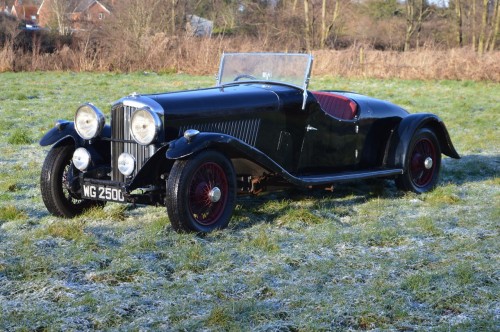
Click Here for Full Screen Image - Click Here to Download Image
 |  |  |  |  | |||||
 |  |  |  |  | |||||
 |
| Lot number | 180 |
|---|---|
| Hammer value | £44,000 |
| Description | Bentley 3.5 Litre Two-Seater Tourer |
| Registration | WG 2500 |
| Year | 1934 |
| Colour | Black |
| Engine size | 3,587 cc |
| Chassis No. | B139AE |
| Engine No. | R581 |
The 2,422 Bentleys produced between 1933 and 1939 are known as the 'Derby Bentleys' after the Rolls-Royce factory in which they were built.
Rolls-Royce had secretly acquired Bentley Motors from the receiver in 1931 and was determined to honour the magnificent sporting heritage that came with this illustrious brand. Although the cars were based on the existing Rolls-Royce 20/25 and 25/30 models, they were much more than a badge-engineering exercise, with considerably more powerful engines and a more sporting chassis which had been developed for the still-born Supercharged Peregrine project.
Referred to when first launched as 'The Silent Sportscar', the Derby Bentley had a Rolls-Royce based 3.5-litre six-cylinder engine fitted with a more sporting cross-flow cylinder head, twin SU carbs and twin fuel pumps. Feeding its 105bhp through a four-speed synchromesh gearbox, the car was good for a genuine 90mph and was widely praised for its combination of speed, refinement and handling prowess. Even WO Bentley himself was reported as saying: "Taking all things into consideration, I would rather own this Bentley than any other car produced under that name."
Faced with increasing competition from the likes of Alvis and Lagonda, in 1936 Rolls enlarged the capacity of the engine to 4.25-litres which boosted the power to 126bhp, allowing a top speed of virtually 100mph and notably improved acceleration. On all models, completed chassis were supplied to the leading coachbuilders of the time and a variety of stunning looking cars resulted, marking what was perhaps the peak period of the British coachbuilders’ art.
This 1934 model was originally ordered with a Mulliner saloon body – not from H J Mulliner as might be assumed, but from Arthur Mulliner, a completely different branch of the family whose Northampton-based firm pre-dated the other by over one hundred years.
At some undertermined point, probably not long after the war, the sporting saloon coachwork was lost and the current two-seater body constructed using what appear to be the original wings, bonnet and bulkhead. When purchased by the vendor in March 2000, it had just received a retrim in red leather and was subsequently treated to a new hood and sidescreens.
At the time of writing, the vendor has been unable to locate his file of information, although for much of his tenure the car has remained in storage and has seen little use. It starts easily and runs smoothly, with all gears working as they should and notably good brakes which pull the car up well.
This car is ready to use and enjoy as is. Given a little attention to the paintwork, it would turn into a super, presentable pre-war Bentley with an excellent turn of speed thanks to its lightweight sporting coachwork.
CATALOGUE AMENDMENT: We have now been able to review its recent history and are able to confirm the following.
In 2008 a bespoke stainless steel exhaust system was fitted at a cost of £560 along with two new rear tyres. In 2012 it had a repair to the starter motor costing £236 and a relined clutch fitted to cure clutch slip, work carried out by Bancroft Racing in Cheshire.